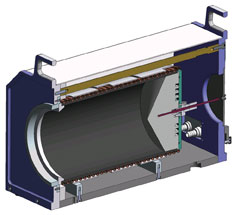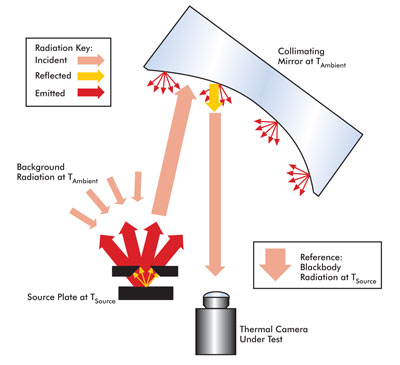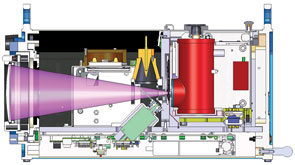As thermal cameras gain ground in the commercial market, testing becomes critical
Dr. David A. Imrie, Optikos Corp.
Thermal imaging, once the domain of the defense sector, is finding applications in a number of commercial and medical fields. As more manufacturers join the thermal camera business, the need to test these devices to recognized standards is becoming increasingly important. After all, they can be fairly tricky instruments to design and build.
Both cooled and uncooled focal plane arrays are sensitive to manufacturing process variations, and thermal camera bodies and lenses are constructed from materials that emit radiation visible to these instruments. The defense sector knows all too well that testing of production units is just as important as the initial qualification of the design.
As thermal cameras find a broader market, the defense industry continues to push the limits of detectable and resolvable temperature differences. Frequently, the subjects of greatest interest have only a small temperature difference compared with the background against which they are viewed. A broadly adopted set of performance metrics exists for thermal imagers. Noise equivalent temperature difference, subjective and objective minimum resolvable temperature difference, minimum detectable temperature difference and modulation transfer function are typical parameters that may need to be measured in a testing laboratory.

The temperature of the blackbody is held constant by circulating water at the required temperature through the coils wrapped around the cylinder and through the channels cut into the back of the re-entrant cone. Winding two sets of coils in a double-helix arrangement and circulating water in opposite directions in each set minimizes thermal gradients.
Of particular importance are those metrics that require the presentation of a target with a precisely known thermal contrast. Four-bar targets, for example, are frequently used to determine the minimum resolvable temperature difference for a thermal imaging system. In these systems, the target, consisting of apertures cut into a target plate, is passively held at ambient temperature, while the temperature of an extended thermal source mounted behind the target plate is actively servoed so as to maintain the desired radiometric temperature difference.
In this case, the radiometric temperature of a target is the temperature of a perfect blackbody that produces the same in-band flux as the target. Using embedded sensors such as platinum resistance thermometers, it is possible to measure the physical temperature of the target and source plates to within a few millikelvin. Knowing the physical temperature difference, however, does not provide us with the precise radiometric temperature contrast of the target.
Two variables to consider
One problem is that the intensity of radiation leaving the target surfaces not only depends on the temperature of the target but also on the emissivity of the surfaces. For an opaque object in thermodynamic equilibrium with its surroundings, the spectral emissivity, ε, is equal to the spectral absorption, α. Many of the coatings applied to thermal target generators have emissivities that approach 1, but none attains it. To a thermal camera, a target with a surface emissivity less than unity appears cooler than an ideal blackbody at the same physical temperature.
Most tests are performed with the target located at an infinite conjugate, and additional losses in target flux occur at the mirrors and lenses used in the collimation system. For the target plate, nonunity emissivity and collimation losses are generally unimportant. To a good approximation, the whole room or enclosure is essentially an isothermal cavity bathing the test apparatus in background radiation at the same temperature as the ambient target plate. For an opaque object in thermal equilibrium, the reflectivity r and the absorption a are related by α + p = 1.

The cooler background radiation does not compensate entirely for the imperfect emissivity of the target, and the radiation from the ambient temperature mirror does not fully compensate for its imperfect reflectivity. The result is that the radiation presented to the camera under test appears to have originated from a blackbody at a temperature less than the physical temperature of the source.
Because the target plate emissivity (absorption) departs from 1 by an amount equal to its reflectivity, and because the temperature of the radiation that it reflects is the same as the temperature of the target, the shortfall in emitted radiation is compensated by the reflected background radiation. To a thermal camera, the target plate appears to radiate the same flux as an ideal blackbody at the same temperature. Even when collimated using mirrors with less than perfect reflectivity, the small portion of the flux absorbed by the mirror is replaced by the flux radiated by the mirror, again at the same ambient temperature as the target plate.
The same is not true for the background source plate. If the source is not an ideal blackbody, then the flux emitted by the heated source necessarily will be less than that radiated by a blackbody at the same temperature. The “missing” flux is only partially replaced by the ambient background radiation. At the surfaces of collimating mirrors, photons are absorbed by less than perfect reflectors but are replaced only by radiation at the temperature of the mirror.
The result is that the heated target appears to be cooler than it really is. In most thermal target projector systems, the source control electronics usually compensate for these effects by setting a physical temperature difference between the foreground and background temperatures that is greater than the radiometric temperature difference demanded by the operator. To do this, the relationship between the radiometric and physical temperature differences for the entire target projection system must be known. One approach sometimes used is to combine the individual component contributions – the source emissivity, the transmission of lenses and windows, and the reflectivity of mirrors in the collimating system. Often, the emissivity values given by manufacturers of thermal target generators are simply the nominal values suggested by paint manufacturers and not actual emissivity measurements for the system that is shipped to the customer.
A more direct method is to perform a radiometric system calibration using a scanning infrared radiometer, such as the RAD-900 model offered by Optikos. Usually the preferred method for establishing the radiometric calibration of a projection system, it produces a result with less uncertainty than that introduced by the stack-up of error bars associated with combining individual contributions. It also is often the only feasible manner in which the radiometric calibration may be maintained as part of an annual cycle because of the impracticability of disassembling the system to measure the performance of individual components.
An enigmatic position
At its most basic, a low-temperature (<100 °C) infrared radiometer is a transfer standard from the nearly ideal blackbody source used to calibrate it to the target projection system. It is a noncontact thermometer that occupies a somewhat enigmatic position in the field of temperature measurement instruments. The measurement of temperature at low-to-moderate temperatures is most accurately carried out by measuring the change in a physical material property, such as that in resistance of a platinum resistance thermometer. At elevated temperatures, where material phase changes start to occur and materials begin to glow, the preferred method changes to optical pyrometry and radiometry.
Such devices are concerned with remotely determining the physical temperature of very hot objects. The low-temperature infrared radiometer, on the other hand, does not seek to measure how warm a target actually is, but instead how warm it appears to be. Only if the target is an ideal blackbody are these two things the same.
The essential elements of the radiometer are an objective lens to collect and focus the incident radiation, filters to select the spectral region of interest, a reflective chopper wheel, an internal reference blackbody source, and a cooled detector and associated amplification and signal processing electronics. Modern radiometers no longer are tethered to bulky racks of electronics but can be controlled from a laptop computer using a single USB connection.

Radiation is focused by the objective lens onto an LN2-cooled detector. The path to the detector is interrupted by a reflective chopper wheel (shown in green), which alternately exposes the detector to the incident radiation and to the radiation from the internal blackbody source (shown in orange).
Other features to look for are operator aids to aiming the instrument, such as an integral boresighted video camera and a visible laser tracer beam.
The purpose of the reflective chopper wheel is to expose the detector alternately to incident radiation collected by the objective lens and the radiation from the internal blackbody reference source. Usually, the internal reference blackbody is held passively at ambient temperature, ensuring that the interior of the instrument behaves as an isothermal cavity.
Using small signal measurement techniques, the instrument determines the physical temperature of the internal blackbody source and the magnitude of the rectified detector signal. The radiometer software combines these measurements with a set of calibration data obtained using a reference cavity blackbody to establish the radiometric temperature of the object being viewed.
Relatively low-cost infrared thermometers expose a detector to infrared radiation and then display the temperature of an object with an assumed emissivity that produces the same signal level. Besides the superior accuracy and thermal resolution of the measurement made using the radiometer, the chief difference between the two instruments is the radiometer’s far smaller field of view.
The RAD-900, for example, has a 300-mm-long focal length lens and a 0.25-mm square detector, giving it an instantaneous field of view on the order of 0.05°. The instrument’s utility is increased by scanning it across the target in angular space. Linear scans of edge targets enable the radiometric calibration coefficients for the target projection system to be extracted, and two-dimensional scans are helpful in verifying the spatial uniformity of sources.
When plotted over a range of target temperature differences spanning approximately 80 °C, the relationship between radiometric and physical temperature difference first appears to be linear. It is not uncommon for some testing facilities to assume that the relationship is simply proportional and to characterize it with a single proportionality constant, which they loosely refer to as the “system emissivity.”
In fact, because it is flux and not temperature that is attenuated by the combined contributions from emissivity and reflectance, and because temperature is not linearly related to flux, the relationship between physical and radiometric temperature is not strictly linear. The departure from linearity may be accounted for using higher-order polynomial terms, and over a relatively modest range of, say, 80 °C, the inclusion of a second-order term usually is adequate to characterize the relationship.
All thermal camera-testing laboratories should be concerned with maintaining an annual calibration of the radiometric temperature contrasts generated by their equipment. Although many laboratories are scrupulous about calibrating the thermal probes used in the target generation equipment, they often are less aware of the importance of maintaining radiometric calibration.
Meet the author
David A. Imrie is vice president and chief technical officer at Optikos Corp.in Wakefield, Mass.; e-mail: [email protected].